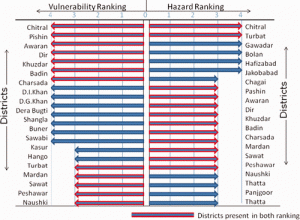Addressee
To the attention of Mr. Azizzuddin Boolani, Board of Director at Aga Khan Foundation Pakistan. Addressing the issue of attaining “universal and equitable access to safe and affordable drinking water” for every citizen of Gilgit Baltistan and Chitral to ensure the population is benefitting from “safely managed drinking water services” by the year 2030.
Author
I am writing to you from the Health department at Aga Khan Foundation Pakistan, Program Manager of the Islamabad division.
Analysis
While WASEP has benefitted many lives, it is flawed because of its inability to be maintained in the long run. The main reason for WASEP’s failure lack of consideration of increased population and natural disaster preparedness. Currently there are no measures in place to prepare for natural disasters in Northern Pakistan even though Chitral and Gilgit Baltistan is one of the highest risk and vulnerable districts in the country (Shown in Figure 1.1).

The Aga Khan Foundation alone is not to blame for this lack of preparedness. The site analysts had not come back with sufficient information to show the repercussions of any natural disasters that may hit Northern Pakistan and its effects on WASEP water supply. The site analysts also did not account for any increase in population as they had predicted the population to stay stagnant or decrease in the years to come.
It is safe to say that lack of data experts and poor judgements led to the premature demise of WASEP. Not only have the recent floods destroyed WASEP’s brilliantly built irrigations systems and pipelines, 80% of the irrigation channels created by the community were also damaged. Furthermore, with the recent land grabbing caused due to increase in land price, people have come back to their hometowns in Northern Pakistan causing a shortage in pipelines that supply sanitary water and an increased demand of portable water.
To be fair, this was Northern Pakistan’s first attempt at aiming to achieve Target 6.1 through international collaboration. Thus, a careful reanalysis of the reasons for failure will lead to the relaunching of this project with better prospects for the future and hopes of WASEP II benefitting Northern Pakistanis for generations to come.
The two failures that will be addressed in WASEP II: better preparedness for natural disasters and ability to meet demands of increased population will ensure the success of the project.